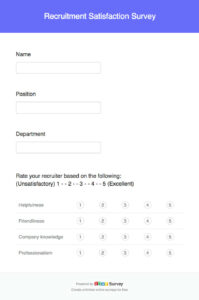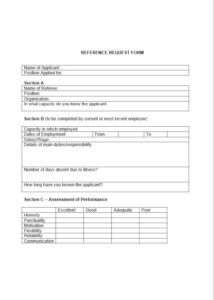Utilizing such a form offers several advantages. It saves time for both the hiring manager and the referee by providing clear guidelines for the information sought. It also ensures legal compliance by focusing on job-related inquiries and minimizing the risk of discriminatory questions. Furthermore, a well-designed form presents a professional image to potential referees, enhancing the organization’s credibility and encouraging thoughtful responses.
The subsequent sections will delve into the key components of an effective form, provide practical examples, and offer best practices for implementation, ensuring the process is both beneficial and user-friendly for all parties involved.
Key Components of a Reference Request Form
Effective reference requests require careful structuring to gather relevant information while respecting the time of the referee. The following components contribute to a comprehensive and efficient process.
1. Applicant Information: This section identifies the candidate clearly, including full name, the position applied for, and the date of application. This provides context for the referee and ensures they are providing feedback for the correct individual and role.
2. Referee Information: Collecting the referee’s name, title, organization, contact information (phone number and email address), and relationship to the applicant establishes clear communication channels and clarifies the nature of their professional association with the candidate.
3. Employment Dates: Requesting the period during which the applicant worked under the referee’s supervision helps establish the relevance and recency of the referee’s experience with the candidate’s performance.
4. Performance Evaluation: This section seeks specific insights into the applicant’s skills, strengths, weaknesses, and overall job performance. Structured questions or rating scales can facilitate consistent and comparable feedback.
5. Job-Specific Questions: Tailoring questions to the specific requirements of the target role ensures the collected feedback directly addresses the essential skills and experience needed for success.
6. Eligibility and Rehire Potential: Inquiries regarding the applicant’s eligibility for rehire offer valuable insights into their past performance and potential future fit within the organization.
7. Open-Ended Feedback: Providing space for the referee to offer additional comments or observations allows for a more nuanced and personalized assessment of the candidate’s qualifications.
8. Authorization and Confidentiality: Including a statement ensuring confidentiality and requesting the referee’s authorization to contact them demonstrates respect for their privacy and professionalism.
A well-designed form incorporates these elements to ensure a thorough understanding of the applicant’s qualifications, facilitating an informed hiring decision.
How to Create a Reference Request Template
Creating a comprehensive reference request template requires careful consideration of the information needed to assess a candidate’s suitability for a position. A well-structured template ensures a consistent and efficient process for gathering valuable insights from referees.
1: Define the Purpose: Clearly outline the objective of the reference check. Identify the key skills, experience, and attributes required for the specific role. This focus guides the development of targeted questions.
2: Gather Essential Information: Include sections for applicant information, referee contact details, and their relationship to the candidate. Specify the dates of employment or association to provide context for the referee’s feedback.
3: Structure Evaluation Criteria: Develop a set of standardized questions or rating scales to evaluate the applicant’s performance, skills, and suitability for the role. Focus on job-related inquiries to ensure legal compliance and consistency.
4: Incorporate Job-Specific Questions: Tailor questions to address the specific requirements of the target position. This ensures the gathered feedback directly relates to the essential skills and experience needed for success.
5: Address Eligibility and Rehire Potential: Include inquiries regarding the applicant’s eligibility for rehire, if applicable. This can offer valuable insights into their past performance and potential future fit within the organization.
6: Include Open-Ended Feedback Opportunities: Provide space for referees to offer additional comments or observations, allowing for a more nuanced assessment of the candidate’s qualifications.
7: Ensure Authorization and Confidentiality: Include a statement ensuring confidentiality and requesting the referee’s authorization to provide feedback. This demonstrates respect for their privacy and professionalism.
8: Review and Refine: Periodically review and update the template to ensure its continued relevance and effectiveness in gathering the necessary information for informed hiring decisions.
A thoughtfully designed template streamlines the reference checking process, providing valuable insights for effective hiring decisions while maintaining professionalism and respecting the time of all parties involved.
Effective candidate evaluation relies heavily on comprehensive information gathering. A well-structured template for soliciting references provides a crucial tool for employers, ensuring a consistent, efficient, and legally sound process for obtaining valuable insights from those familiar with an applicant’s professional history. Such templates offer a standardized framework for gathering feedback on key skills, experience, and overall suitability for a specific role, ultimately empowering informed hiring decisions and contributing to successful workforce development.
Organizations committed to building high-performing teams recognize the value of thorough due diligence in the hiring process. Investing in robust reference-checking procedures, underpinned by a well-designed template, reflects a commitment to selecting top talent and fostering a culture of excellence. This proactive approach contributes significantly to long-term organizational success by ensuring the right individuals are placed in the right roles.



